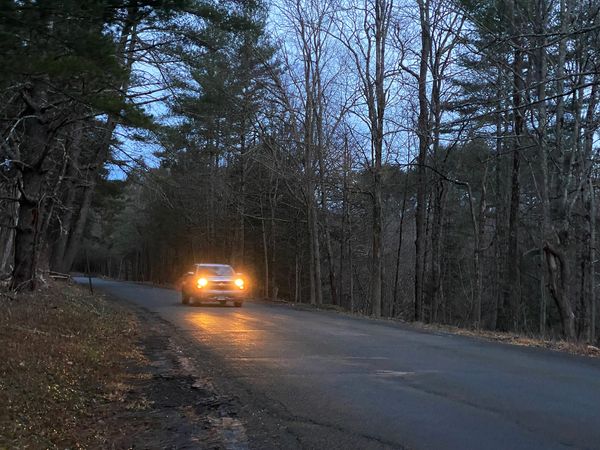Story By Robert Muldoon
Buried deep in a 34-page police report on the death of Marie Thrasher, of Waterbury, are a few words that may explain her last troubled years—and reveal her humanity. But let’s jump to the sad end of her life first.
When a decomposed body was found in the Naugatuck River near Bank Street in February 1990, police suspected foul play. The Incident Report read “D.O.A Murder (River).” A Supplementary Report listed it as a “possible homicide.”
An autopsy identified the victim as a black female, 18-26, 5’9″, 130 lbs, with decomposed fingers. No gunshot, stab wounds, broken bones, blunt trauma or strangulation signs. “Pending further study,” the Medical Examiner could not state a cause of death.
The Waterbury Police searched missing persons and “females who work the streets.” 24-year-old Marie Thrasher fit the victim profile, and had not been seen for months. Her aunt Ruth Thrasher, of 304 Walnut Street, hadn’t seen her in six months. She had been released from Niantic Prison in August of 1989.
Police applied for a search warrant of her dental and medical records from Niantic. They indicated she had been arrested for “FTA-Prost” (Failure To Appear-Prostitution) in July 1989. They also indicated she had a $20 a day habit of “smoking cocaine” thrice weekly; and drank “2/5ths” of rum daily.
Using prison records, Marie Thrasher was identified, but without a cause of death.
Soon after, citing toxicology reports showing a cocaine level of 0.15 (“enough to cause death”), the medical examiner added “drug intoxication” to “drowning” as causes of death. But the examiner went further: noting a possibility that “Marie Thrasher had overdosed and then was put in the river.”
That was it. Early indications of “possible homicide” and “D.O.A. Murder” were dropped. The case was closed. No more investigation into the untimely death of 24-year-old Marie Thrasher who “was put in the river.”
It’s easy to dismiss the case of Marie Thrasher. It’s easy to judge her with a “high risk” lifestyle of drugs and a prostitution arrest.
But one thing you should know about Marie Thrasher, buried deep in that police report. At 19, she lost an infant son. No one can know the suffering that brought, or how or if it altered her life, but she sought help. Her medical records say so.
Been treated for psychiatric illness? “yes Waterbury Hospital – to overcome loss of son’s crib death 1984.”
 |
That terse, hand-scribbled note, might say a lot about Marie Thrasher’s life ending six years later in a river in Waterbury. But her autopsy said nothing about a broken heart—only drugs and drowning.
But a broken heart needs mending and may lead to drugs to numb pain; and drugs may lead to entering a stranger’s car to feed a habit; and entering a wrong car may lead to ending up “put in a river” by a killer. Maybe Marie Thrasher died of a broken heart, just like a lot of people do.
And maybe if the world knew of that that note, and saw a broken-hearted victim, and not a drug addicted prostitute, then maybe the investigation would not have been closed immediately after the toxicology results. After all, why was broken-hearted Marie Thrasher “put in a river”? Who put Marie Thrasher “in a river”?
These questions are unanswered.
In 2016, Rolling Stone Magazine printed a story titled “Why So Many Sex Workers Murders Go Unsolved?” Many reasons were given:
They are “perfect victims” who “don’t leave as much of a trace as a soccer mom who posts on Facebook.”
Society (and police) “just think they’re dirty scummy people” and so investigations are not prioritized.
They live “high risk lifestyles,” estranged from families, meeting strangers in secret places, where “quickly these surreptitious encounters can turn deadly.”
 |
Predators like William Devin Howell, who killed seven sex workers in Connecticut, three from Waterbury, called himself the “Sick Ripper.” In Long Island, four women were murdered in 2009-10. In Denver, a “prostitute killer” murdered 19 from 1975-95. A Baton Rouge serial killer murdered 10 women from 1996-2002.
The list goes on—wherever exists a shadowy underworld where sex is for sale, like Willow and Grove Streets in Waterbury, murders happen. Rolling Stone calls it “an epidemic of terror for a maligned and marginalized community; women with shadow lives and the predators who follow them into the dark.”
Gary Ridgeway, the Green River Killer, who pled guilty to strangling 49 sex workers and runaways in Seattle, said: “I picked prostitutes because they were easy to pick up without being noticed. I knew that they would not be reported missing. I killed prostitutes because I could kill as many as I wanted without getting caught.”
According to a study, 22% of confirmed U.S. serial killer victims between 1970-2009 were “known prostitutes.” That increased to 43% in the past decade. Eric Hickey, author of “Serial Killers and their Victims” said: “Being a prostitute increases your chances of being murdered 200 times.” Killers calculate “they’re easily disposed of and they’re not going to be missed,” Hickey said. “Police won’t look as hard for a missing sex worker as for a ‘respectable’ victim.”
In Waterbury, Dee-Michelle Rodriguez was found near the railroad tracks, by the 200 block of Thomaston Avenue, in May 2007. Rodriguez, universally revered as a “rare and stunning beauty,” was badly decomposed. Initially, police launched a “homicide probe” and an inquest to identify the body—just as with the Thrasher case.

DeeMichelle Rodriguez was a mother of eight children. |
Police said “it did not appear as if she was hit by a train.” Lieutenant Christopher Corbett continued: “We will treat it as a homicide investigation…” Soon after, the medical examiner ruled it a drug overdose. Heads were scratched.
Who put Dee-Michelle Rodriguez by the railroad tracks in Waterbury? Case closed.
In August 1999, Shawn Mae Haskell was found partially clothed in Waterbury by the railroad tracks. To this day, Haskell is so missed that one friend has devoted her life to trying to set up a ministry for outreach to troubled souls on Willow and Grove Streets. Her death too was ruled a drug overdose.
Who put Shawn Mae Haskell by the railroad tracks in Waterbury? Case closed.
A 2021 Southside Weekly story, analyzing 50 unsolved Chicago cases of strangled sex workers, noted: “Sex workers often assume aliases and live transient lives, so it’s hard to pin down who they saw last or where they were leading up to the murder.”
Then there is victim blaming, “the belief that sex workers are responsible for their trauma.” Brenda Myers-Powell, a former sex worker and now advocate, said the attitude is “it’s your fault. You shouldn’t have been out there.”
The cases are hard to solve. Paul Olson, a retired Cook County Sheriff, said, “A lot of times in a homicide, you are killed by someone you know. But these girls are getting into cars with guys they don’t know anything about. They have no idea who they are.”
In 1994, Frederica Spinola, of Waterbury, got into a van at a MacDonalds on Thomaston Avenue, driven by Albert S. Boyson, 77, of Newtown, a driver for Kelley Transit in Torrington. Spinola ended up being ejected from the van at 50 mph on Route 8 near the Campville section of Harwinton, where six bodies of women have been found.

Fredrica Spinola on Grove Street in Waterbury in January 1993. A year later she would be died in a bizarre incident on Route 8 near Campville. |
Boyson said Spinola “freaked out” and “jumped.” The driver of a second vehicle who ran her over, and did not stop, was later arrested for “evading responsibility.” Boyson was questioned and released to drive the van the next day for the transit company. “I have no reason not to believe his story,” state police said, of Boyson, who was a Constable and Boy Scout leader in Newtown.
Olson, the former Sheriff, admitted that colleagues avoided making arrests: “Some guys had the attitude of, ‘If I arrest this guy it’s going to ruin his life, his wife’s going to find out.’”
Costly drug habits force women to make harsh trade-offs in the places they live. Elizabeth Grzywacz, roomed in an office converted to a bedroom, in a ramshackle building on 69 Linden Street, in Waterbury. She lived there free, in exchange for doing janitorial work for Alan Lane, the building owner where Lane Financial operated. Lane, the employer and landlord, showed up for work one Monday morning in 2002 and found Grzywacz bludgeoned to death.
Karen Everett lived in a second-floor apartment just above her place of work in 1988. It was on 2040 North Main Street, back then the home of Lane Financial. Her employer and landlord was Alan Lane. Lane was the last known person to see her late one Friday afternoon in October. Two days later, a hunter found Everett’s body in a ravine by the Naugatuck River in Campville.

Karen Everett was in the National Guard before her life began to spiral downward. |
“About 2/3 of all male serial killers are sexually involved with their victims in some way,” said Hickey, the author and psychologist. Prostitutes are “low-hanging fruit.” If a killer is targeting a sex worker, little planning is required; it’s “as simple as negotiating a fee from across a car window.”
DNA, ballyhooed in solving crimes, did not come into wide use until 2000. Back then, accepted practices for collection were not as exacting as today.
“DNA collection can be hit or miss,” the Baton Rouge Advocate said, discussing 10 cold cases between 1996-2002. “Leads have dried up, and DNA is not likely to be the miracle evidence that it turned out to be in so many other killings.”
The Waterbury Observer has been investigating the unsolved murders, deaths and disappearances of 18 women since 1988, most recently in 2021. Most were from Waterbury with drug problems. Some did sex work to support habits. The bodies of six women were discarded in a dark forested area of Campville in Harwinton, off Route 8, near the banks of the Naugatuck River.
Of the 18 cases, 10 remain unsolved. Three are ruled drug overdoses. Five victims dumped in Campville are unsolved. All are now cold—except the 2021 murder of Brianna Beam, 20, under active investigation.
The cases are alike in many ways—but different. But they all share one thing in common: every victim left family and friends broken-hearted. Just like Marie Thrasher, found floating in 1990 in the Naugatuck River near Bank Street.
Marie Thrasher’s autopsy revealed many things—about drugs and drowning—but one thing was overlooked: her heart just might have been broken, too. That can happen when you lose an infant son to death in a crib, and you are only 19.
No one, this side if heaven, can fix a broken heart. Justice on earth is the nearest remedy.
CALL to POLICE to REOPEN COLD CASES –CRIME SCENE EVIDENCE INCLUDED:
1) KAREN EVERETT (“Brandy”) – age 25
Date Found: 10/16/88 (Valley Rd Harwinton –40 foot embankment by Naugatuck River)
Person Who Found Victim: Deer Hunters
Manner of Death: Strangled
Crime Scene Evidence: light-gray tank top
Last Known Person Seen: Alan Lane, employer and landlord
Last Seen: 2040 North Main Street, home of Lane Financial, where Everett worked and lived on the second floor
Status: Cold Case – Connecticut State Police
2) MILDRED ALVARADO – age 30
Date Found: 1/19/89 (Valley Rd Harwinton—ravine near Naugatuck River)
Person Who Found Victim: Anonymous Caller (police tracked down)
Manner of Death: Strangled
Crime Scene Evidence: Clothed but missing shoes
Status: Cold Case – Connecticut State Police
3) MARIE THRASHER—age 24
Date Found: 2/19/90; body found in Naugatuck River near Bank Street
Person Who Found Victim: Worker on lunch break from Anaconda-America Brass Co
Victim Condition: Decomposed
Crime Scene Evidence: Gray Sweatshirt, green undershirt, jeans and socks, Avon ring (chrome color, with 3 ball type stones in setting). NO SHOES,
Manner of Death: Chief Medical Examiner ruled an overdose
Status: Case Closed—Waterbury Police
4) MARY JO MARKIEWICZ – age 34
Date Found: 11/25/92 -near railroad tracks on Chase River Rd Waterbury
Person Who Found Victim: Vagrant collecting cans
Manner of Death: Stabbed
Crime Scene Evidence: Purple sweat pants and black sneakers with ornate laces
Identifying Characteristics: tattoo of Cross on her Sternum (Markiewicz was Catholic)
Status: Cold Case – Waterbury Police
5) EVELYN BETTANCOURT – age 27
Date Found: 1/3/93 (Valley Rd/Harwinton)
Manner of Death: Shot 4 times
CRIME SOLVED: using Jailhouse “Snitch” – a copycat killing
ARRESTED: Michael Curry, Thomaston, bragged in cell in 1995
Serving 45 years in Jail
6) OLGA MARIE CORNIELES-UBIERA
Date Found: 11/01/94 -(Rte 262- Waterbury Rd in Thomaston – 8 miles south of Campville)
Status: Cold Case – Connecticut State Police
7) FREDERICA SPINOLA – age 40
Date Found: 12/9/94 (Rte 8 Harwinton) –
Manner of Death: Run Over (pushed/fell from van)
Person Who Found Victim: Albert S. Boyson, age 77, van driver for Kelley Transit who was driving the van Spinola tumbled out of
Last Known Person Seen: Albert S. Boyson, van driver
Last Seen: MacDonalds on Thomaston Avenue, where Boyson picked Spinola up
Status: Case Closed– Connecticut State Police Boyson not charged
8) LORI DELGADO – age 41 (Waterbury resident)
Date Found: 8/20/95 Cheshire- Notch Road embankment
Manner of Death: Bludgeoned, blunt head trauma
Believed to be killed elsewhere and dumped
Status: Unknown
9) SHAWN MAE HASKELL
Date Found: 8/99 partially clothed by RR Tracks in Waterbury
Manner of Death: Chief Medical Examiner ruled an overdose
Status: Case Closed—Waterbury Police
10) BERNADINE PAUL (Missing Person) – Age 37
Date Missing: 6/7/00 – Bradlees Parking lot (Chase Ave)
Status: Cold Case – Waterbury Police
11) ELIZABETH GRZYWACZ –Age 34
Date Found: 10/7/2002 – 69 Linden St – naked, bludgeoned
Person Who Found Victim: Alan Lane, employer and landlord
Where Found: 69 Linden Street, home of Lane Financial, where Grzywacz lived in a one-story, office annex (converted to a bedroom) in exchange for janitorial duties
Status: Cold Case – Waterbury Police
12) JESSICA MARIE MUSKUS – age 22
Disappeared on: 7/2004 after leaving home on 27 Bunker Hill Avenue
Date Found: 11/14/2006 (Campville Exit Rte 8/ 300 yds from Valley Rd)
Person Who Found Victim: Hunter
Crime Scene Evidence: Clothing and Duct Tape
Status: Cold Case – Waterbury Police
Below are 3 Waterbury victims of convicted serial killer William Devin Howell, who murdered at least seven women, three from Waterbury. Were there others?
13) MELANIE RUTH CAMALINI (29) – missing 1/1/2003
14) MARILYN GONZALEZ (26) – mother of 2 (2003)
15) MARY JANE MENARD (40) – 10/2003
Substance Abuse Counselor from Waterbury
16) DEE-MICHELLE RODRIGUEZ – Age 36
Date Found: 5/27/2007 – Train Tracks – Thomaston AVE
Manner of Death: Chief Medical Examiner ruled an overdose
Status: Case Closed—Waterbury Police
17) KELSEY MAZZAMARO, 26, of Litchfield
Date Found: murdered on May 6, 2018 in Burlington
Status: Unknown
18) BRIANNA BEAM age 20
Date Found: 12/19/2021
Date Identified: 2/3/22 Identified (Harwinton – 100 feet off Campville Rd)
Status: Active investigation – Connecticut State Police
If you have any information about the lives and unsolved murders of any of these women, please contact the Waterbury Observer at 203-754-4238 or email John Murray at waterburyobserver@gmail.com.

